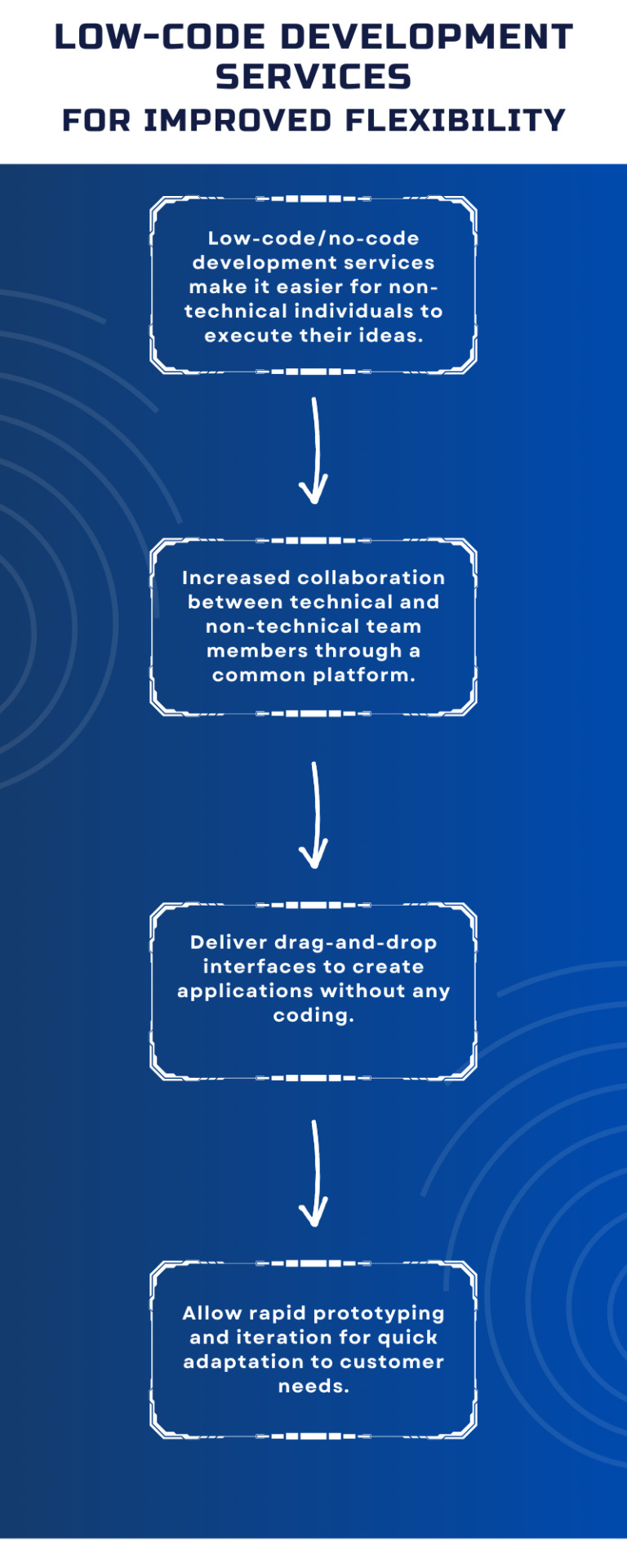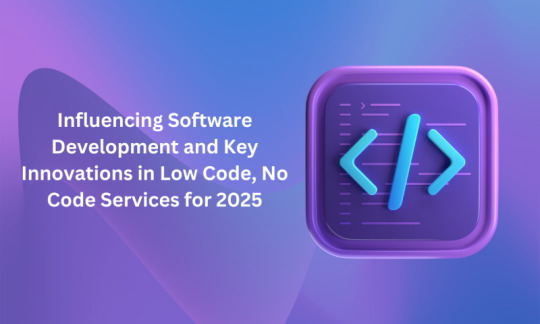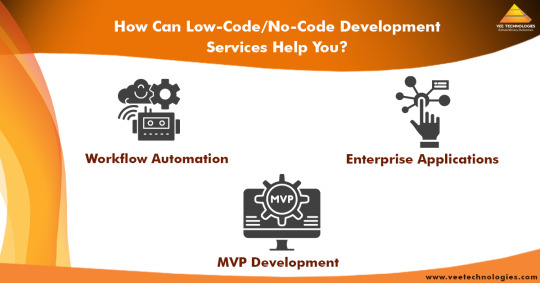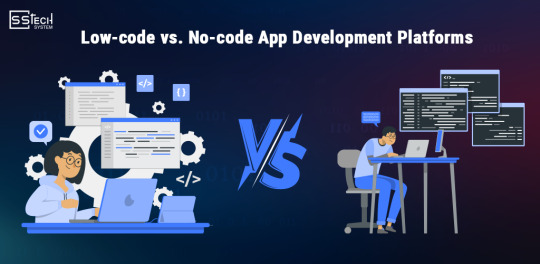#LowCodeDevelopment
Explore tagged Tumblr posts
Text
How Low-Code Platforms Are Transforming Healthcare and Elevating Patient Experience

The healthcare sector is a highly evolving landscape. The current race for digitization has made it crucial for service providers to stay updated with the latest technology and regulations. Patient satisfaction is of the highest requirement, but inefficient processes, paperwork, and security concerns often hinder positive outcomes. To enhance speed, transparency, and efficiency, many providers are turning to low-code platforms, driving digital transformation.
Why Low-Code is a Perfect Fit for Healthcare
Low-code platforms enable both technical and non-technical users to build digital healthcare solutions. It simplifies healthcare operations, speeds-up processes and makes healthcare more accessible for patients.
Most healthcare professionals lack IT training, limiting their ability to use digital tools. Low-code bridges this gap by providing an intuitive interface for rapid, cost-effective app development. With scalable architectures and seamless third-party integration, these platforms improve workflows, patient care, and operational efficiency.
Key Benefits of Low-Code in Healthcare
Workflow Optimization and Automation:
Low-code platforms like iLeap streamline administrative and clinical processes. Automating billing, budgeting, and resource management reduces manual effort and errors. Tasks like appointment scheduling and reminders can also be automated, freeing up time for patient care.
Seamless Integration:
A majority of legacy healthcare enterprises rely on legacy systems which is often a major reason for downtimes and slow processes. A robust low-code platform integrates easily with existing software and third-party applications, ensuring unified workflows without IT disruptions.
Customizable Features:
Low-code solutions automate emails, manage patient records, and schedule appointments efficiently. Platforms like iLeap also support threshold management and escalation for timely responses to critical situations.
Enhancing Patient Care with Low-Code
Patient Registration and Records :
Custom applications streamline patient intake, scheduling, second opinions, and billing, reducing wait times and improving experiences.
Automated Appointment Reminders and Feedback:
By automating reminders and surveys, healthcare staff can focus on critical tasks, reducing no-shows and improving service quality.
Telehealth and Centralized Communication:
Legacy systems cause fragmented communication and delays. Low-code platforms facilitate telehealth solutions, including video consultations, secure messaging, and EHR integration, ensuring timely care.
Compliance and Accountability:
Regulatory compliance is crucial. Low-code solutions streamline reporting and documentation, ensuring transparency and adherence to guidelines. By 2030, on-demand compliance reports will be necessary, making digital transformation essential.
iLeap: Driving Digital Healthcare Transformation
iLeap enables healthcare providers to build secure, scalable applications tailored to their needs. By optimizing workflows, financial management, and patient experiences, iLeap helps organizations stay ahead in digital transformation.
Learn more about iLeap’s low-code application development platform. Schedule a call with us
2 notes
·
View notes
Text

Low-code and no-code development platforms are a boon for non-technical people who want to build and launch their own applications without facing any technical barriers.
Explore more: https://www.veetechnologies.com/services/it-services/product-and-application-development/low-code-no-code-development-services.htm
#NoCode#LowCode#NoCodeDevelopment#LowCodeDevelopment#NoCodeSolutions#LowCodeSolutions#BuildWithoutCode#NoCodeAgency#LowCodeExperts#NoCodeServices
0 notes
Text
Turn Your Ideas into Applications Faster and Easier Than Before with Low-Code/No-Code Development Services

You can get your applications running within a few weeks using low-code/no-code development services, along with reduced development and maintenance costs. LCNC can scale as your business grows and free up your IT teams to focus on high-priority projects, reducing IT backlogs entirely.
Explore more: https://www.veetechnologies.com/services/it-services/product-and-application-development/low-code-no-code-development-services.htm
#NoCode#LowCode#NoCodeDevelopment#LowCodeDevelopment#NoCodeSolutions#LowCodeSolutions#BuildWithoutCode#NoCodeAgency#LowCodeExperts#NoCodeServices
0 notes
Text
Looking for a future-proof, budget-friendly approach to development? Discover if low-code is the answer and leverage its cost-saving potential.
0 notes
Text
Drive Innovation with Low-Code Application Development Services.

Build apps quickly with low-code application development services. Using these, you can reduce coding efforts, organize workflows, and innovate faster with user-friendly, scalable, and efficient development solutions.
Explore More: https://www.veetechnologies.com/services/it-services/product-and-application-development/low-code-no-code-development-services.htm
#LowCodeDevelopment#InnovateWithLowCode#DigitalTransformation#AppDevelopment#NoCodeLowCode#BusinessAutomation#AgileDevelopment#SoftwareInnovation#LowCodeSolutions#TechForBusiness#LowCodeApplication
0 notes
Text
Drive Innovation with Low-Code Application Development Services.

Build apps quickly with low-code application development services. Using these, you can reduce coding efforts, organize workflows, and innovate faster with user-friendly, scalable, and efficient development solutions.
Explore More: https://www.veetechnologies.com/services/it-services/product-and-application-development/low-code-no-code-development-services.htm
#LowCodeDevelopment#InnovateWithLowCode#DigitalTransformation#AppDevelopment#NoCodeLowCode#BusinessAutomation#AgileDevelopment#SoftwareInnovation#LowCodeSolutions#TechForBusiness#LowCodeApplication#VeeTechnologies
0 notes
Text
Influencing Software Development and Key Innovations in Low Code, No Code Services for 2025

Building a software is a nightmare for many people as it generally involves coding. But nowadays, the reality is that anyone can build a software with low code and no code platforms.The main difference between these two are: low code requires minimal code which makes it suitable for developers who want to build complicated app faster, whereas no code requires no coding at all and is perfect for business users who want to create apps without having any technical expertise. As we are in 2025 now, these platforms are getting better and more helpful for various best application management and support companies.How Businesses Use Low Code and No Code PlatformsLet’s have a look at how different sectors and best application management and support companies are leveraging them:HealthcareHospitals use no code platforms to design patient management systems, which reduce administrative burden. AI integration helps in the processing of large datasets for medical research and diagnostics.RetailRetailers usually use low code tools to create customized e-commerce platforms and inventory management systems. Automated customer service chatbots also improve user experiences of best application management and support companies.EducationFor online learning and student monitoring, schools and universities are building applications. Administrative tasks like admissions and fee management are organised using automation.
#LowCode#NoCode#LowCodeDevelopment#NoCodeDevelopment#AppDevelopment#SoftwareDevelopment#DigitalTransformation#Automation#BusinessInnovation#TechSolutions
0 notes
Text
5 Reasons Why FlutterFlow Is Ideal for Fintech Applications
Discover why FlutterFlow is the perfect choice for fintech app development. Learn about its speed, scalability, security features, and user-friendly interface to elevate your fintech solutions.
0 notes
Text

You can get your applications running within a few weeks using low-code/no-code development services, along with reduced development and maintenance costs. LCNC can scale as your business grows and free up your IT teams to focus on high-priority projects, reducing IT backlogs entirely.
Explore more: https://www.veetechnologies.com/services/it-services/product-and-application-development/low-code-no-code-development-services.htm
#NoCode#LowCode#NoCodeDevelopment#LowCodeDevelopment#NoCodeSolutions#LowCodeSolutions#BuildWithoutCode#NoCodeAgency#LowCodeExperts#NoCodeServices
0 notes
Text
Transform Workflows with Low-Code Power Apps Development Solutions
Embrace low-code Power Apps development to streamline operations, increase agility, and enable rapid app deployment tailored to your business needs.

0 notes
Text
Explore the future of low-code development & prepare for transformation with FlutterFlow. Learn how this platform can streamline your app development process.
0 notes
Text
Optimize Your IT Infrastructure with Acumant’s Managed Services
Acumant delivers scalable, secure, and efficient Managed IT Services that empower businesses to focus on their core operations. From cloud management to network security, we provide end-to-end solutions. Discover how Acumant can enhance your IT systems: Acumant Managed Services.
0 notes
Text
Transform your business with tailored digital strategies.Automate tasks. Boost productivity.Leverage AI & ML for smart, data-driven decisions.Scalable cloud solutions for seamless operations.Build apps faster with low-code solutions.Optimize your product life cycle and integrate cutting-edge tech.Discover how we can help you grow today! Transformation and Product Engineering company based in UAE, USA, Europe and India, through cutting-edge IT solutions. Our diverse portfolio includes Generative AI, Commerce Technologies, Cloud management, Business Analytics and Marketing technologies. We are on a mission for Building experiences and influencing change through delivering digital consulting services that drive innovation, efficiency, and growth for businesses globally, with a vision to be the world's most valued technology company, driving innovation, and making a positive impact on the world.
#DigitalTransformation#AITechnology#MachineLearning#CloudComputing#LowCodeDevelopment#Automation#ProductivityBoost#GlobalGrowth#Innovation#TechSolutions#GenerativeAI#Commerce#ITInnovation#GravityEngineering#FutureTech
0 notes
Text
#IBPMS#IntelligentBusinessProcessManagement#ProcessAutomation#BusinessDevelopment#LowCodeDevelopment#GenAI#AI/ML#RPA
0 notes
Text
Low-code vs. No-code app development platforms | SSTech System

In today’s digital world, things move quickly. Consequently, companies try to speed up the software development process to keep up with the growing need to go digital. Low-code vs No-Code app creation tools are one of the new ideas that is causing this change.
These platforms claim to make app creation more accessible by letting regular people, who are sometimes called “citizen developers,” make apps without having to know a lot about code. This comparison will get into the specifics of low-code vs. no-code, looking at their pros, cons, and possible future effects on app creation.
What Makes Low-Code Vs No-Code Different?
Both Low-code app development and no-code systems aim to simplify the process of creating applications but from different perspectives – the users and apps they target differ. Take a closer look at head-to-head comparison:
1. Users you want
Low code: The majority of low-code customers are programmers and IT staff looking for a way to automate the development of highly functional programs.
No-Code: It is made for business users or citizen creators who don’t have any experience in programming. It promotes simplicity as well as usability.
2. Changes and customization
Low-Code: Offers you more freedom and customization options; it can be applied on customized code as well.
No-Code: Nevertheless, it is also challenging to make many changes because most of the elements and themes are already built and ready for deployment.
3. Complexity
Low-Code: This type of programming is suitable for the development of business applications that require complex architecture and scalability, connect to database servers for data processing, contain specialized business logic and have a high-security level.
No-Code: No-code app development is the most suitable for creating basic applications with minimal features. It is usually associated with the internal use of a company to allow it to perform certain business operations or an application for various departments within it.
4. Speed of development
Low-Code: This type of development is much faster than standard development, but it may need some unique code, which can make the development process take longer.
No-Code: This type of development is usually faster than low-code because there is no writing involved. This makes it possible to quickly launch simple apps.
5. Applications and Use Cases in Business
Use Cases for Low-Code
Enterprise Resource Planning (ERP): Making ERP systems that can be expanded and changed to fit different needs.
Customer relationship management (CRM): creating custom CRM systems that work with your business.
Supply chain management: Making complicated supply chain systems that connect to many different data sources.
Financial services: Putting in place safe financial applications that follow the rules.
Use Cases for No Code
Automating internal tasks: Automating internal tasks like hiring new employees, managing projects, and making schedules for workers are examples of internal business tools.
Campaigns for marketing: Making and releasing marketing apps without IT help.
Customer feedback: Making easy tools and polls for getting feedback.
Event management: Making tools that let people sign up for and organize events.
What is low code development?
Low-code development platforms provide a visual developer environment where developers can simply drag parts to the desired location, connect components using simple processes and configure features without requiring much hand-coding. These systems aim to reduce the time and effort needed to create applications but also allow some code modifications.
Pros of using low-code:
Some of the advantages of Low-Code include:
Faster time-to-market: Short development processes enable faster time-to-market.
Flexibility: It allows you to create your own code for specific needs.
Collaboration: It simplifies the work of the IT and business units.
Scalability: It can deal with complex enterprise applications.
What is No-Code Development?
No-code development tools take this notion of simple even further by making application development completely visual. Users can create apps without writing any code using the GUI and themes that come with apps. These platforms are for business users who want to develop working apps fast and easily.
Pros of using No-Code:
Some of the benefits of no-code include:
Accessibility: Enables non-programmers to develop applications.
Cost-effective: It reduces the amount of specialized tools for growth.
Speed: Easy to deploy and test.
Easy to Use: It is easier to learn how to use and to figure out when the layout is simple.
Low-code vs. No-Code: The future of app development
Adoption-driven trends
The use of Low-code vs no-code development is growing because of a number of app development trends, including:
Digital transformation: Companies are under a lot of pressure to quickly digitize their processes, which makes these platforms very appealing.
Shortage of developers: There is a continuing lack of skilled software developers, which makes low-code and no-code options more important.
Agility: Companies need to be able to quickly adapt to changes in the market and customer needs, which supports making apps quickly.
Innovation: Allowing non-technical staff to help build apps is one way to encourage innovation.
Challenges and consideration
Both low-code and No-code app development platforms have problems, even though they have benefits:
Safety: Making sure that apps created on these sites meet safety standards and legal requirements.
Integration: Especially for no-code options, integrating with current systems and data sources can be hard.
Scalability: Low-code app development platforms usually do a better job of scalability than no-code platforms, but no-code platforms might have trouble with needs that are very scalable.
Governance: Keeping an eye on and controlling how apps are made across multiple areas to avoid “shadow IT.”
The future landscape
As these platforms change over time, the following things could happen that could affect future of application development:
Integration of AI: Better AI could make app creation even easier by handling more difficult chores.
Hybrid solutions: Combining low-code and no-code solutions tools to make a more complete working platform is what hybrid solutions do.
Collaboration: Tools that make it easier for business users and IT workers to work together better.
Better personalization: No-code platforms may offer more personalization choices, making the difference between low-code and no-code less clear.
How to choose between No-Code and Low-Code development?
Think about these things when thinking about how to choose between low-code and no-code development:
Project complexity: Low-code works better for complicated projects that need a lot of customization. No-code is best for applications that are simple and easy to understand.
User skills: Check to see how tech-savvy the team is. No-code might be better for business users, while low-code can be useful for IT experts.
Time to market: If speed is very important, no-code might let you launch faster.
Budget: Think about how much each platform will cost, including any licensing fees and possible development costs.
Integration needs: Figure out if you need to connect to other tools and data sources.
How to use Low-Code vs. No-Code?
To make the most of the power of Low-Code vs. No-Code:
Find use cases: To test the platform’s abilities, start with small, non-essential projects.
Train users: Give users the training and materials they need to make good use of these tools.
Monitor and govern: Set up control tools to keep an eye on app development and stop “shadow IT.”
Iterate and scale: To improve applications and make great projects bigger, use an iterative method.
Conclusion
Low-Code vs. No-Code platforms are a big change in the way apps are made because they make them faster and easier for more people to use. Low-code gives complex, scalable apps the freedom they need, while no-code lets business users handle urgent issues without counting on IT. Whether you use low-code or no-code relies on a number of things, such as the difficulty of the project, the skills of the users, and the need for interaction.
As these tools keep getting better, they will definitely be very important for the future of app creation, making it easier for companies to come up with new ideas faster. Businesses can make smart choices and use the full potential of low-code and no-code development to stay ahead in the digital age if they know what they can and can’t do.
#lowcode#nocode#appdevelopment#sstechsystem#citizendeveloper#softwaredevelopment#mobiledevelopment#lowcodedevelopment#nocodedevelopment#india#b2b#business
1 note
·
View note